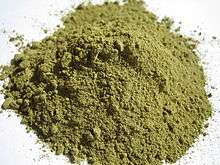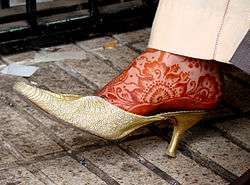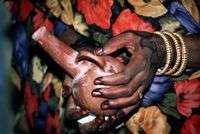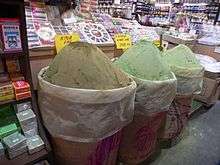Henna
Henna (Arabic: حِنَّاء) is a dye prepared from the plant Lawsonia inermis, also known as hina, the henna tree, the mignonette tree, and the Egyptian privet,[1] the sole species of the genus Lawsonia.
Henna can also refer to the temporary body art resulting from the staining of the skin from the dyes (see also mehndi). Henna has been used since antiquity to dye skin, hair and fingernails, as well as fabrics including silk, wool and leather. Historically, henna was used in the Arabian Peninsula, Indian Subcontinent, near and Middle East, parts of Southeast Asia, Eastern Europe, the Caucasus, Carthage, other parts of North Africa and the Horn of Africa. The name is used in other skin and hair dyes, such as black henna and neutral henna, neither of which is derived from the henna plant.[2][3]
Etymology

The English name "henna" comes from the Arabic حِنَّاء (ALA-LC: ḥinnāʾ; pronounced [ħɪnˈnæːʔ]) or, colloquially حنا, loosely pronounced as /ħinna/.
Preparation and application
Body art
Whole, unbroken henna leaves will not stain the skin. Henna will not stain skin until the lawsone molecules are made available (released) from the henna leaf. However, dried henna leaves will stain the skin if they are mashed into a paste. The lawsone will gradually migrate from the henna paste into the outer layer of the skin and bind to the proteins in it, creating a stain.
Since it is difficult to form intricate patterns from coarsely crushed leaves, henna is commonly traded as a powder[4] made by drying, milling and sifting the leaves. The dry powder is mixed with one of a number of liquids, including water, lemon juice, strong tea, and other ingredients, depending on the tradition. Many artists use sugar or molasses in the paste to improve consistency to keep it stuck to the skin better. The henna mix must rest between 1 to 48 hours before use in order to release the lawsone from the leaf matter. The timing depends on the crop of henna being used. Essential oils with high levels of monoterpene alcohols, such as tea tree, cajeput, or lavender, will improve skin stain characteristics. Other essential oils, such as eucalyptus and clove, are also useful but are too irritating and should not be used on skin.

The paste can be applied with many traditional and innovative tools, starting with a basic stick or twig. In Morocco, a syringe is common. A plastic cone similar to those used to pipe icing onto cakes is used in the Indian culture. In the Western world, a cone is common, as is a Jacquard bottle, which is otherwise used to paint silk fabric. A light stain may be achieved within minutes, but the longer the paste is left on the skin, the darker and longer lasting the stain will be, so it needs to be left on as long as possible. To prevent it from drying or falling off the skin, the paste is often sealed down by dabbing a sugar/lemon mix over the dried paste or adding some form of sugar to the paste. After time the dry paste is simply brushed or scraped away. The paste should be kept on the skin for a minimum of 4 to 6 hours. but longer times and even wearing the paste overnight is a common practice. Removal should not be done with water, as water interferes with the oxidation process of stain development. A cooking oil may be used to loosen dry paste.
Henna stains are orange when the paste is first removed, but darken over the following three days to a deep reddish brown due to oxidation. Soles and palms have the thickest layer of skin and so take up the most lawsone, and take it to the greatest depth, so that hands and feet will have the darkest and most long-lasting stains. Some also believe that steaming or warming the henna pattern will darken the stain, either during the time the paste is still on the skin, or after the paste has been removed. It is debatable whether this adds to the color of the end result as well. After the stain reaches its peak color, it holds for a few days, then gradually wears off by way of exfoliation, typically within 1 to 3 weeks. Adding drops of lemon juice to your new hand of henna will make it last longer.
Natural henna pastes containing only henna powder, a liquid (water, lemon juice, etc) and an essential oil (lavender, cajeput, tee tree etc) are not "shelf stable," meaning they expire quickly, and cannot be left out on a shelf for over 1 week without losing their ability to stain the skin.
The leaf of the henna plant contains a finite amount of Lawsone molecule. As a result, once the powder has been mixed into a paste, this leaching of dye molecule into the mixture will only occur for an average of 2-6 days. If a paste will not be used within the first few days after mixing, it can be frozen for up to 4 months to halt the dye release, for thawing and use at a later time. Commercially packaged pastes that remain able to stain the skin longer than 7 days without refrigeration or freezing contain other chemicals besides henna that may be dangerous to the skin. After the initial 7 day release of lawsone dye, the henna leaf is spent, therefore any dye created by these commercial cones on the skin after this time period is actually the result of other compounds in the product. These chemicals are often undisclosed on packaging, and have a wide range of colors including what appears to be a natural looking color stain produced by dyes such as Sodium Picramate. These products often do not contain any henna. There are many adulterated henna pastes such as these, and others, for sale today that are erroneously marketed as "natural", "pure", or "organic", all containing potentially dangerous undisclosed additives. The length of time a premanufactured paste takes to arrive in the hands of consumers is typically longer than the 7 day dye release window of henna, therefore one can reasonably expect that any premade mass produced cone that is not shipped frozen is a potentially harmful adulterated chemical variety.
Henna only stains the skin one color, a variation of reddish brown, at full maturity 3 days after application.
Powdered fresh henna, unlike premixed paste, can be easily shipped all over the world and stored for many years in a well sealed package.
Body art quality (BAQ) henna is often more finely sifted than henna powders for hair.
Hair dye
History
In Ancient Egypt, Ahmose-Henuttamehu (17th Dynasty, 1574 BCE): Henuttamehu was probably a daughter of Seqenenre Tao and Ahmose Inhapy. Smith reports that the mummy of Henuttamehu's own hair had been dyed a bright red at the sides, probably with henna.[5]
In Europe, henna was popular among women connected to the aesthetic movement and the Pre-Raphaelite artists of England in the 1800s. Dante Gabriel Rossetti's wife and muse, Elizabeth Siddal, had naturally bright red hair. Contrary to the cultural tradition in Britain that considered red hair unattractive, the Pre-Raphaelites fetishized red hair. Siddal was portrayed by Rossetti in many paintings that emphasized her flowing red hair.[6] The other Pre-Raphaelites, including Evelyn De Morgan and Frederick Sandys, academic classicists such as Frederic Leighton, and French painters such as Gaston Bussière and the Impressionists further popularized the association of henna-dyed hair and young bohemian women.
Opera singer Adelina Patti is sometimes credited with popularizing the use of henna in Europe in the late nineteenth century. Parisian courtesan Cora Pearl was often referred to as La Lune Rousse (the red-haired moon) for dying her hair red. In her memoirs, she relates an incident when she dyed her pet dog's fur to match her own hair.[7] By the 1950s, Lucille Ball popularized "henna rinse" as her character, Lucy Ricardo, called it on the television show I Love Lucy. It gained popularity among young people in the 1960s through growing interest in Eastern cultures.[8]
Muslim men may use henna as a dye for hair and most particularly their beards. This is considered sunnah, a commendable tradition of the Prophet Muhammad. Furthermore, a hadith (narration of the Prophet) holds that he encouraged Muslim women to dye their nails with henna to demonstrate femininity and distinguish their hands from those of men. Thus, some Muslim women in the Middle East apply henna to their finger and toenails as well as their hands.
Today

Commercially packaged henna, intended for use as a cosmetic hair dye, is available in many countries, and is now popular in India, as well as the Middle East, Europe, Australia, Canada and the United States. The color that results from dying with henna depends on the original color of the hair, as well as the quality of the henna, and can range from orange to auburn to burgundy. Henna can be mixed with other natural hair dyes including Cassia obovata for lighter shades of red or even blond, or with indigo to achieve brown and black shades. Some products sold as "henna" include these other natural dyes. Others may include metal salts that can interact with other chemical treatments, or oils and waxes that may inhibit the dye, or dyes which may be allergens.
Traditions of henna as body art
The different words for henna in ancient languages imply that it had more than one point of discovery and origin, as well as different pathways of daily and ceremonial use.
Henna has been used to adorn young women's bodies as part of social and holiday celebrations since the late Bronze Age in the eastern Mediterranean. The earliest text mentioning henna in the context of marriage and fertility celebrations comes from the Ugaritic legend of Baal and Anath,[9] which has references to women marking themselves with henna in preparation to meet their husbands, and Anath adorning herself with henna to celebrate a victory over the enemies of Baal. Wall paintings excavated at Akrotiri (dating prior to the eruption of Thera in 1680 BCE) show women with markings consistent with henna on their nails, palms and soles, in a tableau consistent with the henna bridal description from Ugarit.[10] Many statuettes of young women dating between 1500 and 500 BCE along the Mediterranean coastline have raised hands with markings consistent with henna. This early connection between young, fertile women and henna seems to be the origin of the Night of the Henna, which is now celebrated worldwide.
The Night of the Henna was celebrated by most groups in the areas where henna grew naturally: Jews,[11] Muslims,[12] Sikhs, Hindus, Christians and Zoroastrians, among others, all celebrated marriages and weddings by adorning the bride, and often the groom, with henna.
Across the henna-growing region, Purim,[11] Eid,[13] Diwali,[14] Karva Chauth, Passover, Nowruz, Mawlid, and most saints' days were celebrated with some henna. Favorite horses, donkeys, and salukis had their hooves, paws, and tails hennaed. Battle victories, births, circumcision, birthdays, Zār, as well as weddings, usually included some henna as part of the celebration. Bridal henna nights remain an important custom in many of these areas, particularly among traditional families.

Henna was regarded as having Barakah ("blessings"), and was applied for luck as well as joy and beauty.[15] Brides typically had the most henna, and the most complex patterns, to support their greatest joy and wishes for luck. Some bridal traditions were very complex, such as those in Yemen, where the Jewish bridal henna process took four or five days to complete, with multiple applications and resist work.
The fashion of "Bridal Mehndi" in Pakistan, Bangladesh, Northern Libya and in North Indian diasporas is currently growing in complexity and elaboration, with new innovations in glitter, gilding, and fine-line work. Recent technological innovations in grinding, sifting, temperature control, and packaging henna, as well as government encouragement for henna cultivation, have improved dye content and artistic potential for henna.
Though traditional henna artists were Nai caste in India, and barbering castes in other countries (lower social classes), talented contemporary henna artists can command high fees for their work. Women in countries where women are discouraged from working outside the home can find socially acceptable, lucrative work doing henna.[16] Morocco, Mauritania,[17] Yemen, Libya, Somalia, Sudan, the United Arab Emirates India and many other countries have thriving women's henna businesses. These businesses are often open all night for Eid, Diwali and Karva Chauth. Many women may work together during a large wedding, wherein hundreds of guests have henna applied to their body parts. This particular event at a marriage is known as the Mehndi Celebration or Mehndi Night, and is mainly held for the bride and groom.
Regions
Bridal henna nights are a popular tradition in North Africa, the Horn of Africa, South East Asia, the Arabian Peninsula, the Near East and South Asia.
Egypt
In Egypt, Henna is an Ancient tradition practised among women on many occasions. At weddings, all women gather the night before the big day and start having Egyptian Henna drawings all over their hands and then on the feet but with lesser extent. Egyptian women also use Henna in different colours as a natural and healthy way to dye their hair, since local made Henna is used for smoothing hair too.
Algeria
In Algeria, the bride's mother-in-law traditionally presents her with jewelry and paints the henna on her hands.
Morocco
In Morocco, henna is applied to a bride's hands and feet during a ceremonial henna day, prior to the wedding. Her hands are then wrapped in cotton and sprinkled with rose water. The wrapping of the hands allow the henna to set to a deep crimson tint. Most of the women in the bride's and groom's family will in turn have henna applied to their hands with less extensive work. Henna is used by women of all ages ceremoniously or decoratively.
India
In India, as a part of Hindu, Muslim, and Sikh weddings, henna is applied during wedding ceremonies. Traditionally it is thought that the darker the henna on the bride's hand, the more intensely her husband will love her. It is an important part of many Hindu festivals (such as Karva Chauth and Diwali), as well as during Eid. It is a common practice among Indians, particularly elderly ones, to dye their hair using henna. There is a huge demand in India for the 'Mehendiwaalas', or the people who are skilled in applying mehendi during weddings.
Bangladesh and Pakistan
In Bangladesh, henna is used on hands and feet by brides before their wedding, and by many women for Eid al-Fitr and Eid al-Adha. Often the female friends and relatives of the groom design or choose the design for the hands and feet of bride. It is also used by men to color their hair. This also occurs in Pakistan.
Singapore and Malaysia
In Malaysia, henna is used to adorn women's palms, arms and feet as part of pre-wedding celebrations, Eid al-Fitr and Eid al-Adha. Often, a henna ceremony may be held called 'Berinai'. The bride and groom each have their hands stained, but in a trio of ceremonies. The first being three days before the wedding, the second within two days before the wedding and the third which is normally held three days after the wedding. Singapore holds the same traditions.
Israel
In Israel, Middle Eastern communities and families, Jewish, Christian, and Muslim, sometimes choose to have a henna party the night or week before a wedding.[18]:32 The henna party is smaller than the wedding, as only closer friends and family members are invited. The bride and groom wear traditional costumes, as do some of the main guests. There is much dancing and music, especially when the henna is brought out. The henna is usually presented in a deep dish with lit candles in it and carried by the grandmother. She applies the henna onto the palms of the bride and groom and they are blessed. Subsequently, guests stain their palms with henna as well. There are variations in customs in Arab communities (such as the communities of Yemen, Morocco, and Jordan).[19]
Somalia
In Somalia, henna is worn by Somali women on their hands, arms, feet and neck during weddings, Eid ul-Fitr, Ramadan, and other festive occasions. Somali henna designs are similar to those in the Arabian peninsula, often featuring flower motifs and triangular shapes. The palm is also frequently decorated with a dot of henna and the fingertips are dipped in the dye. Henna parties are usually held before a wedding takes place.
Tunisia
In Tunisia, prenuptial henna celebrations last for seven days. On the third day, the bride wears a traditional dress and has henna painted on her hands and feet. The groom's pinky finger is painted with henna on the sixth day.
Turkey
In Turkey, henna is sold in convenience stores and markets, such as the Spice Bazaar in Istanbul. It is applied onto the palms of a bride the day before her wedding and to those of the guests. Up until recent years it was used in the rural regions as a hair colour by the older women.
Health effects
Henna is known to be dangerous to people with glucose-6-phosphate dehydrogenase deficiency (G6PD deficiency), which is more common in males than females. Infants and children of particular ethnic groups, mainly from the Middle East and North Africa, are especially vulnerable.[20][21] Though user accounts cite few other negative effects of natural henna paste, save for occasional allergic reactions, pre-mixed henna body art pastes may have ingredients added to darken stain, or to alter stain color. The health risks involved in pre-mixed paste can be significant. The United States Food and Drug Administration (FDA) does consider these risks to be adulterants and therefore illegal for use on skin.[22] Some pastes have been noted to include: silver nitrate, carmine, pyrogallol, disperse orange dye, and chromium.[23] These have been found to cause allergic reactions, chronic inflammatory reactions, or late-onset allergic reactions to hairdressing products and textile dyes.[24][25]
Regulation
The U.S. FDA has not approved henna for direct application to the skin. It is however grandfathered in as a hair dye, and can only be imported for that purpose.[22][26] Henna imported into the U.S. that appears to be for use as body art is subject to seizure,[27] but prosecution is rare.
Varieties
Natural henna
Natural henna produces a rich red brown stain which can darken in the days after it is first applied. It is sometimes referred to as "red henna" to differentiate it from products sold as "black henna" or "neutral henna" may not actually contain henna, but are instead made from other plants or dyes.
Neutral henna
Neutral henna does not change the color of hair. This is not henna powder; it is usually the powder of the plant Senna italica (often referred to by the synonym Cassia obovata) or closely related Cassia and Senna species.
Black henna

Black henna powder may be derived from indigo (from the plant Indigofera tinctoria). It may also contain unlisted dyes and chemicals[28] such as para-phenylenediamine (PPD), which can stain skin black quickly, but can cause severe allergic reactions and permanent scarring if left on for more than 2–3 days. The FDA specifically forbids PPD to be used for this purpose, and may prosecute those who produce black henna.[29] Artists who injure clients with black henna in the U.S. may be sued for damages.[30]
The name arose from imports of plant-based hair dyes into the West in the late 19th century. Partly fermented, dried indigo was called black henna because it could be used in combination with henna to dye hair black. This gave rise to the belief that there was such a thing as black henna which could dye skin black. Indigo will not dye skin black. Pictures of indigenous people with black body art (either alkalized henna or from some other source) also fed the belief that there was such a thing as black henna.
para-Phenylenediamine
In the 1990s, henna artists in Africa, India, Bali, the Arabian Peninsula and the West began to experiment with PPD-based black hair dye, applying it as a thick paste as they would apply henna, in an effort to find something that would quickly make jet-black temporary body art. PPD can cause severe allergic reactions, with blistering, intense itching, permanent scarring, and permanent chemical sensitivities.[31][32] Estimates of allergic reactions range between 3% and 15%. Henna does not cause these injuries.[33] Black henna made with PPD can cause lifelong sensitization to coal tar derivatives[34] while black henna made with gasoline, kerosene, lighter fluid, paint thinner, and benzene has been linked to adult leukemia.[35]
The most frequent serious health consequence of having a black henna temporary tattoo is sensitization to hair dye and related chemicals. If a person has had a black henna tattoo and later dyes their hair with chemical hair dye, the allergic reaction may be life-threatening and require hospitalization.[36] Because of the epidemic of PPD allergic reactions, chemical hair dye products now post warnings on the labels: "Temporary black henna tattoos may increase your risk of allergy. Do not colour your hair if: ... – you have experienced a reaction to a temporary black henna tattoo in the past."[37]
PPD is illegal for use on skin in western countries, though enforcement is difficult. Physicians have urged governments to legislate against black henna because of the frequency and severity of injuries, especially to children.[38] To assist the prosecution of vendors, government agencies encourage citizens to report injuries and illegal use of PPD black henna.[39][40] When used in hair dye, the PPD amount must be below 6%, and application instructions warn that the dye must not touch the scalp and must be quickly rinsed away. Black henna pastes have PPD percentages from 10% to 80%, and are left on the skin for half an hour.[23][41]
PPD black henna use is widespread, particularly in tourist areas.[42] Because the blistering reaction appears 3 to 12 days after the application, most tourists have left and do not return to show how much damage the artist has done. This permits the artists to continue injuring others, unaware they are causing severe injuries. The high-profit margins of black henna and the demand for body art that emulates "tribal tattoos" further encourage artists to deny the dangers.[43][44]
It is not difficult to recognize and avoid PPD black henna:[45]
- if a paste stains skin on the torso black in less than ½ hour, it has PPD in it.
- if the paste is mixed with peroxide, or if peroxide is wiped over the design to bring out the color, it has PPD in it.
Anyone who has an itching and blistering reaction to a black body stain should go to a doctor, and report that they have had an application of PPD to their skin.
PPD sensitivity is lifelong. A person who has become sensitized through black henna tattoos may have future allergic reactions to perfumes, printer ink, chemical hair dyes, textile dye, photographic developer, sunscreen and some medications. A person who has had a black henna tattoo should consult their physician about the health consequences of PPD sensitization.
See also
References
- ↑ Bailey, L.H.; Bailey, E.Z. (1976). Hortus Third: A concise dictionary of plants cultivated in the United States and Canada. New York: Macmillan. ISBN 978-0025054707.
- ↑ Cartwright-Jones, Catherine (2004). "Cassia Obovata". Henna for Hair. Retrieved 5 May 2013.
- ↑ Dennis, Brady (26 March 2013). "FDA: Beware of "black henna" tattoos". The Style Blog. The Washington Post. Retrieved 5 May 2013.
- ↑ "Henna Powder of Prem Dulhan". Lia. Retrieved December 23, 2015.
- ↑ G. Elliott Smith, The Royal Mummies, Duckworth Publishing; (September, 2000)
- ↑ "Aesthetics". Retrieved 15 August 2011.
- ↑ Pearl, Cora (2009). The Memoirs of Cora Pearl. 13. General Books LLC. ISBN 9781151590527.
- ↑ Sherrow, Victoria (2006). Encyclopedia of Hair: A Cultural History. Greenwood. pp. 206–207. ISBN 978-0313331459.
- ↑ de Moor, Johannes C. (1971). The seasonal pattern in the Ugaritic myth of Balu, according to the version of Ilimilku (Alter Orient und Altes Testament). Kevelaer: Butzon & Bercker. ISBN 978-3-7887-0293-9. OCLC 201316.
- ↑ D̲oumas, Christos (1992). The wall-paintings of Thera. Athens: Thera Foundation. ISBN 978-960-220-274-6. OCLC 30069766.
- 1 2 Brauer, Erich; Raphael Patai (1993). The Jews of Kurdistan. Detroit: Wayne State University Press. ISBN 978-0-8143-2392-2. OCLC 27266639.
- ↑ Westermarck, Edward (1972) [1914]. Marriage ceremonies in Morocco. London: Curzon Press. ISBN 978-0-87471-089-2. OCLC 633323.
- ↑ Hammoudi, Abdellah (1993). The victim and its masks: an essay on sacrifice and masquerade in the Maghreb. Chicago: University of Chicago Press. ISBN 978-0-226-31525-6. OCLC 27265476.
- ↑ Saksena, Jogendra (1979). Art of Rajasthan: Henna and Floor Decorations. Delhi: Sundeep. OCLC 7219114.
- ↑ Westermarck, E. (1926). Ritual and Belief in Morocco Vols 1 & 2. London, UK: Macmillan and Company, Limited
- ↑ "Easy Mehndi Design Tutorial". 4 December 2014.
- ↑ Tauzin, Aline (1998). Le henné, art des femmes de Mauritanie. Paris: UNESCO. ISBN 978-92-3-203487-8.
- ↑ Rosenhouse, Judith (1 January 2000). "A comparative study of women's wedding songs in colloquial Arabic". EDNA, Estudios de Dialectología Norteafricana y Andalusí. 5: 29–47. Retrieved 31 August 2018.
- ↑ Sharaby, Rachel (2006). "The Bride's Henna Ritual: Symbols, Meanings and Changes". Nashim: A Journal of Jewish Women's Studies & Gender Issues (11): 11–42. JSTOR 40326803.
- ↑ "Henna and Glucose-6-phosphate dehydrogenase deficiency". The Henna Page.
- ↑ de Groot, Anton C. (July 2013). "Side-effects of henna and semi-permanent 'black henna' tattoos: a full review". Contact Dermatitis. 69 (1): 1–25. doi:10.1111/cod.12074. PMID 23782354.

- 1 2 "Temporary Tattoos & Henna/Mehndi". Food and Drug Administration.
- 1 2 Kang IJ, Lee MH (July 2006). "Quantification of para-phenylenediamine and heavy metals in henna dye". Contact Dermatitis. 55 (1): 26–9. doi:10.1111/j.0105-1873.2006.00845.x. PMID 16842550.
- ↑ Dron P, Lafourcade MP, Leprince F, et al. (June 2007). "Allergies associated with body piercing and tattoos: a report of the Allergy Vigilance Network". European Annals of Allergy and Clinical Immunology. 39 (6): 189–92. PMID 17713170.
- ↑ Raupp P, Hassan JA, Varughese M, Kristiansson B (November 2001). "Henna causes life threatening haemolysis in glucose-6-phosphate dehydrogenase deficiency". Archives of Disease in Childhood. 85 (5): 411–2. doi:10.1136/adc.85.5.411. PMC 1718961. PMID 11668106.
- ↑ "§ 73.2190 Henna". Listing of Color Additives Exempt from Certification. Federal Register. 30 July 2009. Retrieved 3 August 2009.
- ↑ Accessdate.fda.gov
- ↑ Singh, M., Jindal, S. K., Kavia, Z. D., Jangid, B. L., & Khem Chand (2005). "Traditional Methods of Cultivation and Processing of Henna. Henna, Cultivation, Improvement and Trade". Henna: Cultivation, Improvement, and Trade. Jodhpur: Central Arid Zone Research Institute. pp. 21–24. OCLC 124036118.
- ↑ FDA.gov
- ↑ Rosemariearnold.com
- ↑ Van den Keybus C.; Morren M.A.; Goossens A. (September 2005). "Walking difficulties due to an allergic reaction to a temporary tattoo". Contact Dermatitis. 53 (3): 180–1. doi:10.1111/j.0105-1873.2005.0407m.x. PMID 16128770.
- ↑ Stante M, Giorgini S, Lotti T (April 2006). "Allergic contact dermatitis from henna temporary tattoo". Journal of the European Academy of Dermatology and Venereology. 20 (4): 484–6. doi:10.1111/j.1468-3083.2006.01483.x. PMID 16643167.
- ↑ Jung P.; Sesztak-Greinecker G.; Wantke F.; Götz M.; Jarisch R.; Hemmer W. (April 2006). "A painful experience: black henna tattoo causing severe, bullous contact dermatitis". Contact Dermatitis. 54 (4): 219–20. doi:10.1111/j.0105-1873.2006.0775g.x. PMID 16650103.
- ↑ Lifelong damage from black henna, Hennapage.com
- ↑ Hassan, IB; Islam, SI; et al. (July 2009). "Acute leukemia among the adult population of United Arab Emirates: an epidemiological study". Leukemia & Lymphoma. 50 (7): 1138–47. doi:10.1080/10428190902919184. PMID 19557635.
- ↑ Severe allergic hair dye reactions in 8 children. Heidi Sosted1, Jeanne Duus Johansen, Klaus Ejner Andersen, Torkil Menné, Contact Dermatitis, Volume 54, Issue 2, pages 87–91, February 2006
- ↑ Commission Directive 2009/134/EC of 28 October 2009 amending Council Directive 76/768/EEC concerning cosmetic products for the purposes of adapting Annex III thereto to technical progress
- ↑ "p-Phenylenediamine in Black Henna Tattoos A Practice in Need of Policy" in Children Sharon E. Jacob, MD; Tamar Zapolanski, BA; Pamela Chayavichitsilp, BA; Elizabeth Alvarez Connelly, MD; Lawrence F. Eichenfield, MD Arch Pediatr Adolesc Med. 2008;162(8):790–792.
- ↑ DOH.state.fl.us
- ↑ HC-SC-GC.ca
- ↑ "Acute fingertip dermatitis from a temporary tattoo and quantitative chemical analysis of the product" Avnstorp, C., Rastogi, S., and Menne, T. Contact Point, 2002, p. 119
- ↑ Marcoux, D.; Couture-Trudel, P.; Riboulet-Delmas, G.; Sasseville, D. 2002. Sensitization to Para-Phenylenediamine from a Streetside Temporary Tattoo. Pediatric Dermatology 19, 6:498–502.
- ↑ Önder M (2003). "Temporary holiday tattoos may cause lifelong allergic contact dermatitis when henna is mixed with PPD". Journal of Cosmetic Dermatology. 2 (3–4): 126–130. doi:10.1111/j.1473-2130.2004.00083.x. PMID 17163917.
- ↑ Önder M, Asena Atahan Ç, Öztaş P, Orhan Öztaş M (2001). "Temporary henna tattoo reactions in children". International Journal of Dermatology. 40 (9): 577–579. doi:10.1046/j.1365-4362.2001.01248.x.
- ↑ HC-SC.GC.ca
Further reading
- Semwal, Ruchi Badoni; Semwal, Deepak Kumar; Combrinck, Sandra (August 2014). "Lawsonia inermis L. (henna): Ethnobotanical, phytochemical and pharmacological aspects". Journal of Ethnopharmacology. 155 (1): 80–103. doi:10.1016/j.jep.2014.05.042. PMID 24886774.
| Wikimedia Commons has media related to Mehndi. |
| Wikimedia Commons has media related to Henna. |
| Look up henna in Wiktionary, the free dictionary. |
.jpg)

